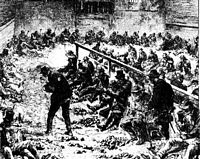
View of workhouse yard in the hungry forties
1595 Bishop's Bible
Inscription in Bible
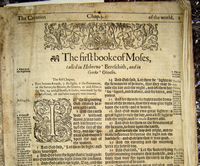
Page from the 'Treacle' Bible(click to enlarge)
History: Faith in Action
The close of the 17th and early part of the 18th century saw many mid-Essex Quakers in difficult financial circumstances, and support for the needy tended to focus on fellow Quakers - not least to try and keep them out of the workhouse. Mention is made in 1707 of an estate left by Deborah Etney of Ulting for poor Quakers, and two years later it was recorded that the half-yearly interest on this legacy was £1 15s 3d which was divided among six poor Quakers; and for over 250 years interest from this legacy helped mid-Essex Quakers. It is recorded that in 1807 two mid-Essex Quakers, one of whom was William Marriage, lent money for the purchase of two houses behind the workhouse for use as 'pest houses', or infirmaries.
The business of mid-Essex Quakers was carried out at the Monthly Meetings, and seemed to be a male-dominated affair. However in 1752 a women's Monthly Meeting was established, with the men and women meeting together for worship before splitting into two distinct meetings to discuss business, and it seems that this women's meeting became the main vehicle for social action.
The story of one poor Quaker comes to us from the minutes of the women's Monthly Meeting, and ranges over 30 years. Elizabeth Lumm was a poor Quaker who for ten years was employed to clean the Chelmsford Meeting House, being paid 20s in 1765.
In 1782, when she could no longer do the work, local Quakers provided her with a small allowance, and arranged for another poor Quaker to board her. When eventually she became very feeble, they paid a girl to look after her, and she died in 1795 at the age of 70.
Mid-Essex Quakers still own a Bishop's Bible, printed in 1595, which has what seems to be Elizabeth Lumm's signature on the inside cover, dating from when, in 1786, a meeting minute asks more affluent Quakers to turn out their books and Bibles to give to poorer members.
The first Bible in English was the Great Bible, commissioned by Henry VIII, and first printed in 1539. However, the Bishops were aware that the Great Bible - which was the only version then legally authorized for use in Anglican worship - was severely deficient in that much of the Old Testament was translated from the Latin Vulgate, rather than from the original Hebrew, Aramaic, and Greek. In an attempt to replace the objectionable translation, they circulated one of their own, which became known as the Bishops' Bible. The promoter of the exercise, and the leading figure in translating was Matthew Parker, Archbishop of Canterbury.
The Bishops' Bible owned by Mid-Essex Quakers is also known as a 'Treacle Bible', since Jeremiah 8:22 was mis-translated as "Is there no tryacle (treacle) in Gilead" - in the Authorised version of 1611, 'treacle' was changed to 'balm'
It is believed that George Fox used a similar Bible, so it must have been a valued Quaker possession.
The minutes record that the winters of 1794/5 and 1804/5 were particularly severe, and Quakers were active in gathering subscriptions from Chelmsford to provide coal and bread for the poor.
The 'hungry forties' were a period in the early 1840s when Britain experienced an economic depression, causing much misery among the poor. In 1839 there was a serious slump in trade, leading to a steep increase in unemployment, accompanied by a bad harvest. The bad harvests were repeated in the two following years and the sufferings of the people, in a rapidly increasing population, were made worse by the fact that the corn laws seemed to keep the price of bread artificially high. During this time many mid-Essex Quakers became bankrupt.
Records of one family illustrate the support given by local Quakers. Sarah Thorpe was the widow of a carpenter, and during the period 1824 - 1836 she had nine children, her husband apparently dying about the time of the birth of the last child. Mid-Essex Quakers found that the money that they had available for relief was low, so in the first year of Sarah's widowhood they had to reduce the grants to poor Quakers from 18s, to a bushel of flour and 1s 6d. When this gift was given to her, Sarah roundly abused the bearer. In fact she was so abusive that two months later the Monthly Meeting disowned her for slandering a member, and for begging as well as for threatening Quakers. At the same time, Monthly Meeting sent her eldest boy to Ackworth Quaker School, near Pontifract, and later apprenticed him. She then wrote to Monthly Meeting saying that she was taking her case to Quarterly Meeting, and when the matter came before twelve members of the Quarterly Meeting, the Monthly Meeting decision to disown her was upheld. Mid-Essex Quakers still paid her 8s per week, and gave her 3 pecks of flour. In the following year Mid-Essex Quakers apprenticed another of her sons to a tinman in Wandsworth for £40. In 1841 the family cost Mid-Essex Quakers £82.17.4 (£3,600 today), and even when she moved to Sheffield she remained a charge on Mid-Essex Quakers until her death, and they then paid for her burial.
A recent view of the Institute building
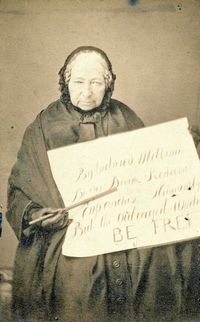
Anne Knight with an anti-slavery poster
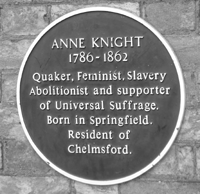
Plaque on the Anne Knight Building in Duke Street.
In parallel with this support for poor Quakers, Mid-Essex Quakers were also involved in many projects both locally and nationally. In 1818, Quakers formed the Chelmsford Provident Society, to encourage thrift amongst the working classes. In 1840, work began on a large building on the Moulsham side of the stone bridge in the High Street. The Institute (see photo) was for "the instruction of those more advanced in life". Opened in 1841, the inaugural meeting was a lecture on emancipation of slaves by John Candler, who had been sent to the West Indies by local Quakers on an information gathering exercise.
By 1840, Chelmsford was home to a branch of the Womens' Anti-Slavery Society - formed by a most formidable resident, Anne Knight.
Her Quaker father, William Knight had moved to Chelmsford from Thaxted to get married to Priscilla Allen - daughter of William Allen, a London brewer well known in radical and nonconformist circles - and they set up residence and a grocers shop in the High Street. It was there that their third child, Anne Knight, was borne in 1786.
The Knights were related to several of the leading Quaker families of England, and they had a numerous circle of local acquaintance, including reformers like Joseph Marriage, a Chelmsford abolitionist. William is mentioned in connection with many Quaker initiatives in the town, and was clearly both an affluent and influential figure.
Anne's life to the age of about 50 was spent mostly at her family home, first in Chelmsford, and then, following the death of her father, moving to the 'Quiet House' in Springfield with her mother, where she followed the ordinary pursuits of an unmarried provincial lady. However, by 1830, she had become deeply involved in the anti-slavery movement. She canvassed from door to door with petitions, arranged for public meetings, saw to the printing of tracts and leaflets, collected money, distributed literature, and travelled frequently to London where she met and worked with national leaders, including Thomas Clarkson, James Cropper, Joseph Sturge, Richard and Hannah Webb, and Elizabeth Pease.
She allied herself with the extreme wing of abolitionism, and carried on a spirited correspondence with William Lloyd Garrison and his leading supporters in America. The World Antislavery Convention of 1840 in London gave her the opportunity to meet Garrison, Wendell Phillips, Lucretia Mott, and other American delegates. The occasion was a turning-point in her own political development. The Convention's refusal to seat female delegates and the heated debates and discussions on the matter left her convinced of the pressing need to campaign for women's rights.
She was, if not the actual pioneer, a very early advocate of votes for all women over 21 who had freehold property valued at over 40s per year. There is a record of her impassioned plea for this course to take place in the Council Room at Chelmsford in 1852.
To gain a wider audience for her ideas Anne Knight adopted publicity techniques often used by abolitionists and religious enthusiasts. She composed and had printed handbills and pamphlets, usually couched as an open letter to some public figure whose inconsistency, or infidelity to principle, had caught her attention. More novel in form were her gummed labels, bearing miniature essays or snippets of poetry, printed on brightly coloured paper, to be affixed to the outside of letters. The so-called "first leaflet on women's suffrage" is one of these labels.
The old Quaker Meeting House in Duke Street, opposite the rail station, has a commemorative plaque (with an error concerning her birthplace), and is now known as the Anne Knight Building in her honour. Even better, a village, Knightsville, was named after her in Jamaica.
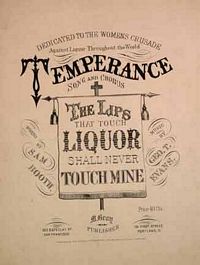
A temperance song
Drink was a scourge of the poor of Victorian England, and the Quaker women of Chelmsford were prominent in the temperance movement that sought to redress this. It is recorded that a Temperance Meeting was held in 1874 at Coval Hall, the home of the Marriage family.
Following this, a Women's Temperance Society was formed which had 54 members in 1875, with a Band of Hope (for working class children) with 29 members. Sixty public meetings were held, and a tract was sent to every doctor in a five mile radius of Chelmsford. They also called on 27 clergy in the district, and distributed over 2,000 tracts.
Charlotte Marriage, who lived in Coval Hall, owned some land at the corner of Broomfield Road, and here a coffee house was established, known as the Red Cow, to provide an alternative to the less salubrious drinking establishments in town. However the locals knew it as the "Charlotte Arms"!
